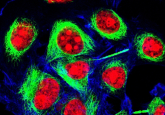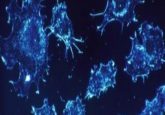Novel tool for visualizing cancer cell dynamics

A fluorescent probe for visualizing the signaling dynamics in metastatic cancer cells has been developed.
A research team at the University of Turku (Finland), led by Johanna Ivaska and James Conway, has developed a novel fluorescent probe for visualizing signaling dynamics in invading breast cancer cells. This tool uncovered new therapeutic possibilities for limiting breast cancer spread and increased understanding of cancer cell invasion, which could extend to other solid tumors.
When breast cancer progresses from ductal carcinoma in situ (DCIS), a pre-malignant solid tumor, to invasive ductal carcinoma (IDC), patients experience metastatic disease and a considerably poorer prognosis. During the process of metastasis, the movement of cancer cells is regulated by several different signals; however, how the cells detect, interpret and react to these signals has been difficult to observe.
For instance, integrins – mediators of binding to several extracellular matrix components – are known to be involved in tumor initiation and growth by bridging the gap between cancer cells and the extracellular matrix. Despite this, the role of integrin phosphorylation in cancer has not been fully investigated, largely due to a lack of tools to interrogate integrin β1 phosphorylation, a key member of the integrin family.

The signals underlying the spatial: key techniques evolving cancer research
Shiva Malek discusses the techniques she uses to investigate cancer cell signaling and the tumor microenvironment.
To address this gap, the team developed a fluorescent resonance energy transfer reporter for integrin β1 phosphorylation, named Illusia. This innovative tool enables researchers to visualize the previously invisible signaling dynamics in living cancer cells.
“Signaling networks inside cells control everything from growth to movement, but visualizing this in living cells requires new and refined methods,” explained Conway. “I set out to see these invisible signals and came up with a new tool, which we call Illusia, to do just that.”
The research team focused on identifying factors that regulate the metastatic movement of breast cancer cells. Using their new visualization tool, they screened 96 protein tyrosine phosphatases to uncover regulators for integrin phosphorylation and metastasis, finding Shp2 to be a key regulator of metastasis through the regulation of cancer cell interactions with surrounding tissue.
Additionally, the team found that inhibition of Shp2 significantly inhibited cell migration and invasion, further highlighting integrin phosphorylation to be important for cancer cell invasion and metastasis.
This research not only enhances our understanding of the complex mechanisms behind cancer metastasis but also identifies potential targets for developing new therapeutic approaches for breast cancer, which the team is now exploring.





